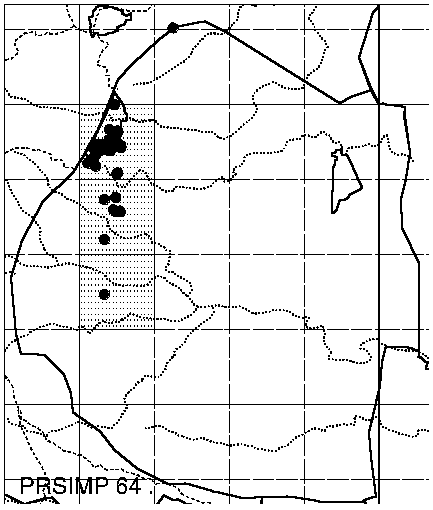
Home
Mission
Overview of Project
Project Staff
Sponsors
Achievements
Checking, Illustrations
Upcoming Activities
Id and Species Lists
Protea Information
Protea Gallery
Growing Proteas
Interim Dist. Maps
Publications
Afrikaanse Inligting
![]()
IDM Swaziland - Dwarf Grassland Sugarbush - Protea simplex
| A solid black dot indicates where the species is found. Protea simplex - Dwarf Grassland Sugarbush is a dwarf shrub with a woody rootstock and multiple stems. The stems are erect, not branching and slender (2-5 mm diameter), and hairless. The involucral bracts are hairless. The leaves arise all around the stem, and point upwards with the stem. Pr simp is only known from the western highlands. Although common in Malalotja, numbers of records decline rapidly towards the south. We appear to have this species at most of the known areas. However, it is very cryptic and can easily be overlooked. There is a record (MSA 921209 01) of "Frequent" plants on the Swaziland border at 2531 CD (Duurstede Farm, 0.7km SW of The Bearded Man): Some must surely be on the Swaziland side – please collect a specimen for the Swaziland National Herbarium. It is very easy to miss this species. So we should appreciate more data from the higher altitude grasslands. It has recently been atlassed from around Vryheid, so there is no reason why it should not occur even further south. Please help! |
 |
Potential Problems
Young Pr caffra plants are very similar to Pr simplex. Although adult Pr caffra are trees, they need to grow large enough to survive fires. Thus young plants form an underground rootstock and produce many stems, which are burned down with every fire, until stems are thick enough to "escape" fires and thus grow up into trees. The moment one branch is thick enough, the other basal branches are shed and the plant assumes its tree-like habit. It thus differs from Pr simplex, which never grows into a tree, and its thin branches usually burn in every fire. The easiest way to distinguish the two species is by the very thin stems in Pr simplex, and the much thicker stems in Pr caffra. The stems in Pr caffra are often branched – seldom so in related species. Pr caffra may stay as a resprouter for decades until fire frequency and intensity allow escape into the tree form. Both differ from Pr parvula with its creeping stems laying flat on the ground.
The difference between Pr parvula and Pr simplex, is that Pr parvula creeps along the ground, whereas Pr simplex has erect stems. Pr parvula also has long stalks to the flowerheads. Although this difference is quite distinctive, many people have misidentified plants of this species as Pr simplex, being caught out by its rarity and occasional plants that are more robust and more erect.